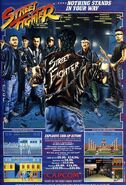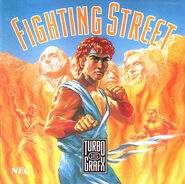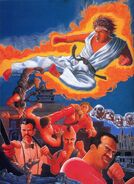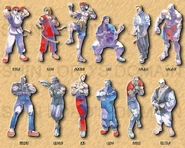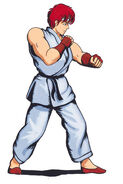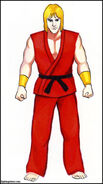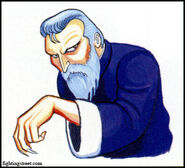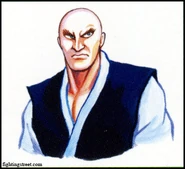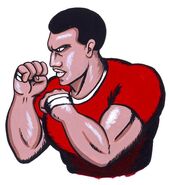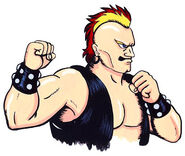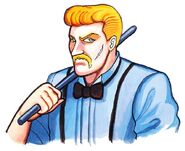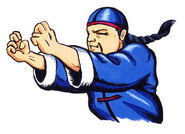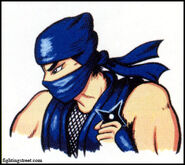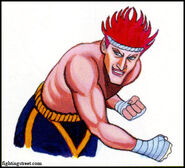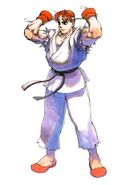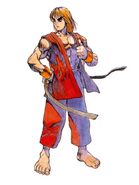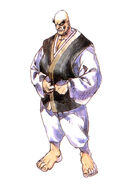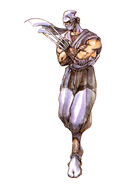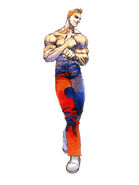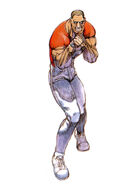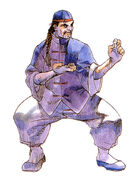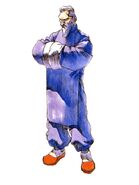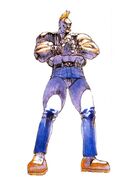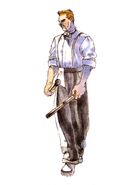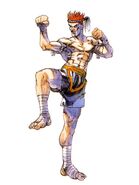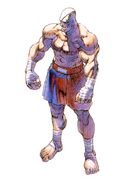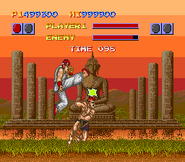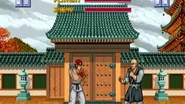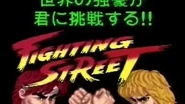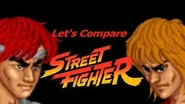Street Fighter is a 1987 arcade game developed by Capcom. It is the first fighting game produced by the company and the very first game in the Street Fighter series. While it did not achieve the same popularity as its sequels when it was first released, the original Street Fighter introduced some of the conventions made standard in later games, such as attack buttons and special command based techniques. A port for the TurboGrafx-CD was released under the title Fighting Street in 1988.
Gameplay
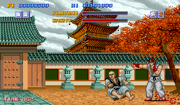
Ryu vs. Retsu.
The player competes in a series of one-on-one matches against a series of computer-controlled opponents or in a single match against another player. Each match is a series rounds in which the player must defeat their opponent in less than 30 seconds. If a match ends before a fighter is knocked out, then the fighter with the greater amount of hit points left will be declared the round's winner. The player must win two rounds in order to defeat their opponent and proceed to the next battle. If the third round ends in a tie, then the computer-controlled opponent will win by default or both players will lose. During the single-player mode, the player can continue after losing and fight against the opponent they lost the match with. Likewise, a second player can interrupt a single-player match and challenge the other player to a match.
The game controls consists of an eight-directional joystick and depending on the cabinet: six attack buttons, three punch buttons and three kick buttons of differing speed and strength; or two mechatronic pads for punches and kicks that determined the strength level of the player's attacks. The player uses the joystick to move towards or away from an opponent, as well to jump, crouch and defend against an opponent's attacks. By using the attack buttons/pads in combination with the joystick, the player can perform a variety of attacks from a standing, jumping or crouching positions. There were also three special techniques, performed by inputting a specific directional-based command and button combination. These techniques were the Hadoken, the Shoryuken and the Tatsumaki Senpukyaku. Unlike the subsequent Street Fighter sequels and other later fighting games, the specific commands for these special moves were not given in the arcade game's instruction card, which instead encouraged the player to discover these techniques on their own.
Characters
The player takes control of a Japanese martial artist named Ryu, who competes in an international martial arts tournament to prove his strength. The second player takes control of Ryu's former training partner and rival Ken Masters, who challenges Ryu in the game's 2-player matches. Normally the player takes control of Ryu in the single-player mode, however if the player controlling Ken defeats Ryu in a 2-player match, then the winning player will play the remainder of the game as Ken. The differences between the characters are mainly aesthetic, as both of them have the same moves and techniques.
| Name | Country | Appearrance | Notes |
|---|---|---|---|
|
Ryu
Ken Masters |
Japan
United States |
|
The single-player mode consists of a series of battles against ten opponents from five different nations. At the beginning of the game, the player can choose the country where their first match will take place, with available choices of Japan or the United States, as well as China or England, depending on the DIP switch setting. The player will then proceed to fight against the nation's two representing opponents before proceeding to the next country. In addition to the regular battles, there also two types of bonus games which player can compete for additional points, including a table breaking and brick breaking bonus games. After defeating the initial eight, the player will travel to Thailand to fight against the final two opponents.
|
Country |
Name |
Appearance |
Notes |
|---|---|---|---|
|
Japan |

|
Retsu is an excommunicated Shorinji Kempo instructor. | |

|
Geki is a claw-wielding ninja. | ||
|
United States |

|
Joe is an underground martial art champion. | |

|
Mike is a former heavyweight boxer who once killed an opponent in the ring. | ||
|
China |

|
Lee is an expert in Chinese martial arts. | |

|
Gen is an elderly professional killer who has developed his own murderous martial art style. | ||
|
England |

|
Birdie is a tall bouncer who uses a combination of wrestling and boxing techniques. | |

|
Eagle is a club-wielding bodyguard of a wealthy family. | ||
|
Thailand |

|
Adon is the number one disciple of Sagat. He is participating in the first World Warrior tournament to prove to the world that he is more than just a lesser version of the "Emperor of Muay Thai". | |

|
Sagat is the "Emperor of Muay Thai”, the greatest Muay Thai fighter there is. But that isn't enough for him. He wants to be the greatest fighter in the world! He hosted the first World Warrior tournament to prove it, and great warriors from around the world came to prove their strength. He fires Tiger Shots and also uses the hopping Tiger Knee. |
Development
Street Fighter was directed by Takashi Nishiyama and planned by Hiroshi Matsumoto, who both previously worked on the overhead beat 'em up Avenger. The two men would leave Capcom after the production of the game and were employed by SNK, developing most of their fighting games.
Arcade versions
There were two different arcade cabinet versions of the game: a Regular version, which was sold as a tabletop cabinet in Japan and as an upright overseas, that featured the same six button configuration later used in Street Fighter II and a Deluxe cabinet that features two-pressure sensitive pads. The pressure-sensitive pads determine the strength and speed of the player's attacks based on how hard they were pressed. In the American and Worldwide versions of the game, Ryu's and Ken's voices were dubbed so that they yelled the names of their moves in English. The localizations of the subsequent games left the characters' voices in their original Japanese language.
Ports
Street Fighter was ported under the changed title Fighting Street for the TurboGrafx-CD and released in 1988 with an arranged soundtrack. This version was developed by Alfa System and published by NEC Avenue in North America and Hudson Soft in Japan; it is now available on the Nintendo's Wii Virtual Console. Due to the lack of a six-button controller available for the TurboGrafx-16 at the time this version was released, the strength level of the attacks were determined by how long either of the action buttons were held down.
Versions of Street Fighter for the Commodore 64, ZX Spectrum, Amstrad CPC, DOS, Amiga, and Atari ST were developed by Tiertex; these ports were published by U.S. Gold in 1988 in Europe.
An emulation of the original arcade version is featured in Capcom Arcade Hits Volume 1 for Windows PC, Capcom Classics Collection Remixed for the PlayStation Portable, and Capcom Classics Collection Vol. 2 for the PlayStation 2 and Xbox.
Gallery
Promotional Art and Packaging
Official Art
Original release artwork
Capcom Classic Collection artwork
Screenshots
Videos
Trivia and Notes
- Whenever a character wins a round or the match, the victory messages would say "[Character name] won the [round number] round" and "[Character name] won the fight over enemy," regardless if the game was played in single-player mode or 2-player mode. Starting in Street Fighter II, the victory messages and the Game Announcer would only say "[Character name] wins" in 2-player games; in single-player games, the Game Announcer would say "You Win" if the player won the battle, or "You Lose" if the battle was lost.



